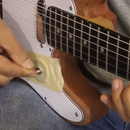Introduction: SOLID Kids Table With 2x3s and Glue
Do you need solid a table made mostly with glue? If so, then this will work quite well, and while its designed for kids, the concept can be modified for adults or other furniture situations.
Note that it is fairly heavy, so be sure to take any appropriate precautions.
Step 1: Materials Needed (Initial Cuts)
- (10) 2x3 lumber 48" long
- (6) 2x3 lumber 44" long
- (14) 2x3 lumber 30" long
- (12) 2x3 lumber 15" long
- Wood Glue
- Stain
- Urethane
- (6) ~3" wood screws (likely optional)
These materials are roughly what I used, but the design is versatile, and can be modified to suit your needs. Note that 48" long lumber (or a little shorter to account for cutting) is nice because it is half of a standard 8' piece of lumber.
Step 2: Tablesaw Cuts
Cut the larger dimension down to 2" with a table saw, taking off the side radii. One could probably do this better with a planar if available to also help make things flat.
Step 3: Glue, and Glue, and Glue, and Glue
Glue the top together as shown, leaving alternating space on the side for the legs. To ensure it's square, measure from each corner to the opposite—should be the same, otherwise you've just got a parallelogram!
Step 4: Hammer Time!
Time to assemble everything. First put the middle supports in with glue, and a mallet as needed, let that set, then apply glue and beat the top into place (don't forget the glue as I did the first time, and be sure the sawed side is up on the top and out on the legs).
Use a square throughout to check that that the angles are correct.
Step 5: Error! Error!
If you used a planar, and/or did everything perfectly, perhaps this won't be necessary. Fill in gaps by cutting thin angled pieces off of your cut 2x3s with a miter saw, then insert in gaps with mallet and break off.
Recessions can be sanded to some extent, but deep caps, add glue and cover with sawdust (sander-dust?) conveniently produced when sanding.
Step 6: Sand, Stane & 'Thane
Sand until things are nice and smooth, continuing the last step to some extent. Wipe down with a cloth.
Stain and urethane to suit. I used cherry stain then three coats of urethane, though after the next optional step for the most part.
Step 7: Optional: Screws and Plugs
While theoretically glue should hold things together, to give your design a bit more strength, add some screws as shown. To make it look even better, I made plugs using a hole saw, then countersunk the screw locations with a 5/8 inch paddle bit. This concealed things nicely, but there can be a bit of a gap which you may need to fill in with glue and/or urethane.
I chose to leave it unstained as a bit of a contrasting element.
Step 8: Enjoy!
So far the desk looks great, and has held up well. I'm quite pleased with it, as is my son. Note the supports on the bottom, which give it a bit more strength, and allow for storage.
Thanks for checking it out. Lots more projects on my YouTube page, and/or you might enjoy this "Massive Standing Desk" if you're looking for something larger.













